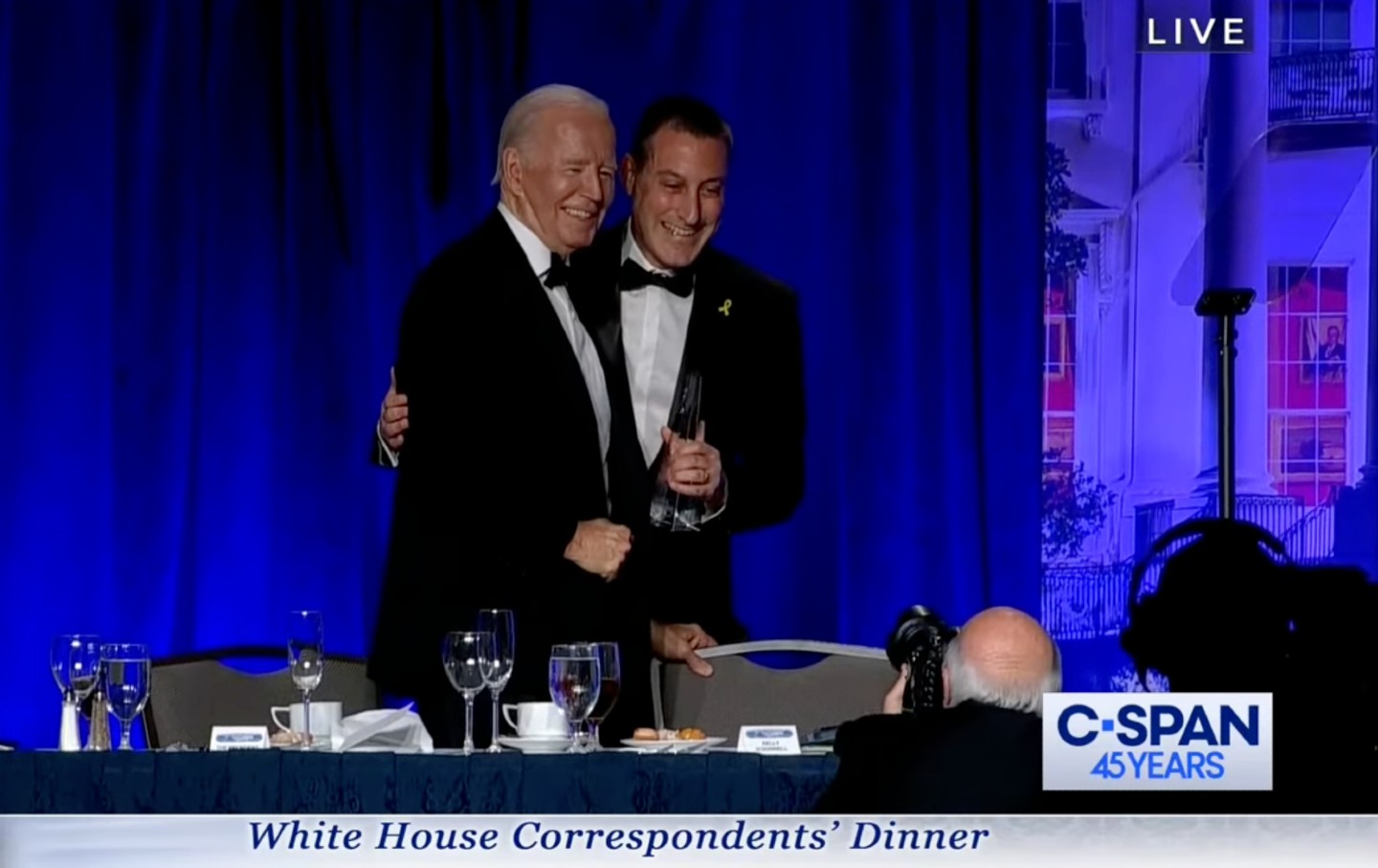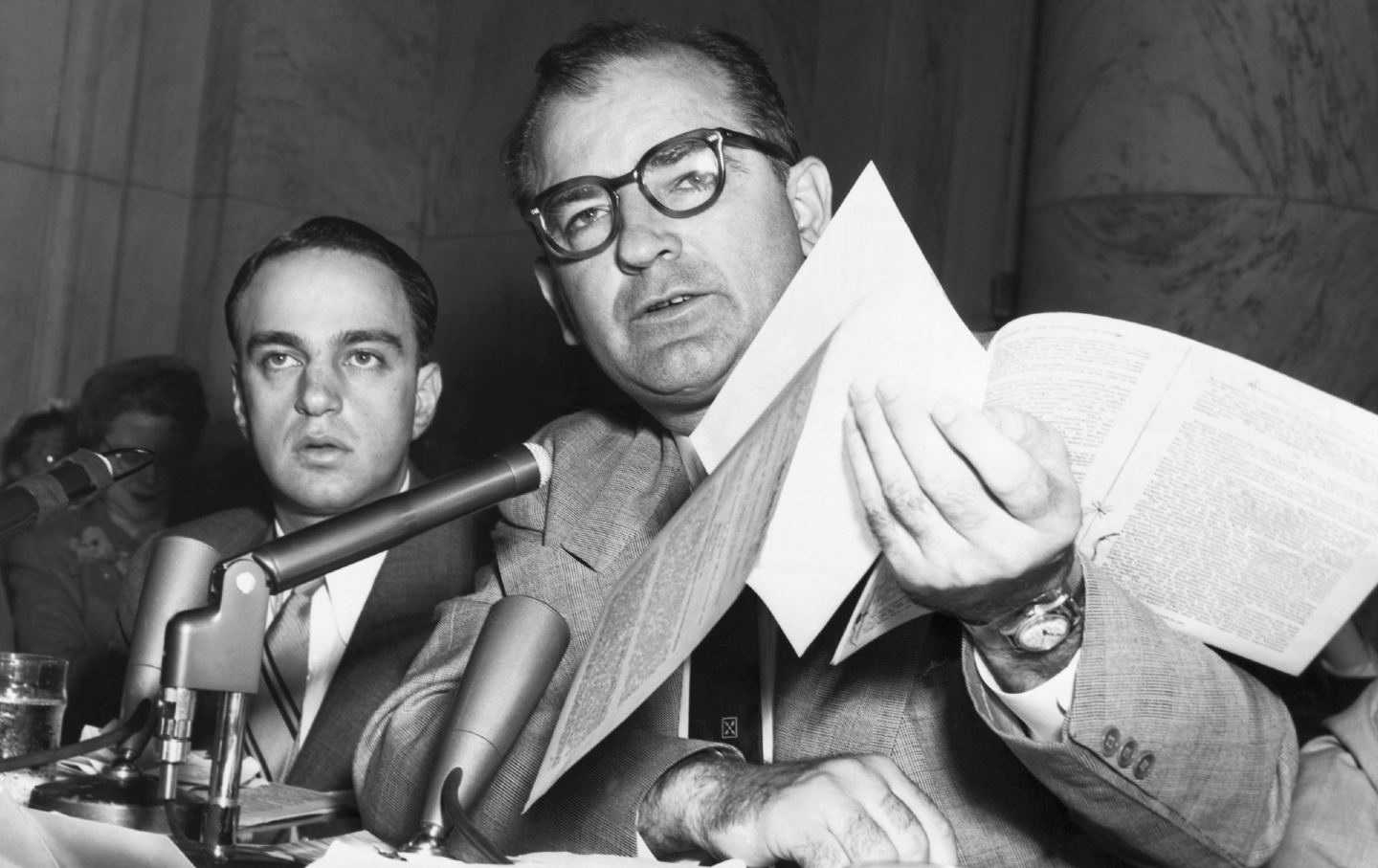How the US Media Helped the Biden Administration Distance Itself From the Horrors of Gaza
White House–curated stories of performative outrage and feigned helplessness provided cover for an administration arming death on an industrial scale.

An analysis of press coverage of the first year of the siege, bombing, and invasion of Gaza reveals a US media eager to produce narratives that allow the White House to distance itself from the moral, social, political, and professional consequences of their support for Israel. White House and State Department reporters at major US outlets, we will show, consistently took self-serving claims by anonymous aides at face value, did not interrogate clear conflicts of interest, and focused too much on alleged personality disputes, unverifiable states of mind, and assumed benevolent motives over material policy.
This distancing of the White House from the carnage in Gaza is achieved through three reporting genres: Helpless Biden, Fuming/Deeply Concerned Biden, and Third-Partying.
- Helpless Biden is any report, analysis, or opinion that describes Biden as unable to do anything to stop Israel from committing war crimes or end the war overall. This is typically framed as a “limit” to US power, often accompanied with a picture of Biden looking overwhelmed, sad, or doddering. These are sourced almost entirely by anonymous Biden aides and Biden allies in the think-tank world.
- Fuming/Deeply Concerned Biden is any report, analysis, or opinion that paints Biden as secretly upset, outraged, or privately sad or anguished about civilian casualties. These articles are also sourced almost entirely by anonymous Biden aides and Biden allies in the think-tank world.
- Third-Partying is a variation of an anti-labor propaganda concept whereby corporations treat unions as somehow separate from workers and worker democracy in order to portray unions as an outside “third party.” Just the same, media reports consistently paint the United States as separate from the conflict, despite its being the major patron of one side, deploying troops and military hardware, assisting in military operations, providing intel, and protecting Israel at the United Nations. The US media consistently frames the United States as a neutral party—even a humanitarian force—always looking (but, mysteriously, always failing) to end the conflict. This is typically done through coverage of largely fictitious ceasefire talks, whereby US media conflates efforts for a short-term pause for the purpose of hostage exchanges with “ending the war.”
Before detailing the three media genres helping the White House distance itself from the horrors of Gaza, we must establish two premises:
1. The Biden White House could—and indeed still can—end Israel’s bombing, siege, and occupation of Gaza whenever it wishes and simply isn’t, because it broadly agrees with it.
The evidence that Biden has sufficient leverage to compel Israel to end its military campaign in Gaza is well-documented and widely understood. Seven US-based unions, representing 6 million workers (AFA, APWU, IUPAT, SEIU, UAW, UE, and NEA), and over 250 humanitarian organizations (among them OxFam, Amnesty International, Save the Children, and Doctors Without Borders) have called for an arms embargo against Israel pursuant to this end. And Israeli officials themselves routinely acknowledge that such leverage gives the US dispositive say over what the Israelis do and don’t do.
In the early days of the war, critics pressed Israeli Defense Minister Yoav Gallant about why Israel agreed to allow in limited humanitarian aid to Gaza. He responded, “The Americans insisted, and we are not in a place where we can refuse them. We rely on them for planes and military equipment. What are we supposed to do? Tell them no?” Retired Israeli Maj. Gen. Yitzhak Brick said in a November 2023 interview, “All of our missiles, the ammunition, the precision-guided bombs, all the airplanes and bombs, it’s all from the US. The minute they turn off the tap, you can’t keep fighting. You have no capability.… Everyone understands that we can’t fight this war without the United States. Period.”
In a recent book on Biden, The Last Politician, Franklin Foer reports how Biden put an end to Israel’s bombing of Gaza in 2021 with a single phone call. After Netanyahu “struggled to justify his request for more bombing of Gaza because he “couldn’t point to fresh targets that needed striking,” Biden said, according to Foer, “Hey, man, we’re out of runway here. It’s over.” And then, Foer wrote, “like that, it was over. By the time the call ended, Netanyahu reluctantly agreed to a cease-fire that the Egyptians would broker.”
The Financial Times wrote in its October 25 editorial, “US President Joe Biden must end the year-long cycle of death and destruction.… Biden has the tools to rein in Netanyahu. He must halt the offensive arms sales to Israel that enable its relentless bombing of Gaza and Lebanon.”
But most persuasive of all is the fact that a good portion of the articles we will be discussing that suggest Biden is helpless to end Israel’s military campaign concede themselves that Biden can do this, but simply doesn’t want to. Yet these articles breeze past this reality, burying it in a “to be sure” paragraph further down on the page or treating it as polemical guesswork from “critics” of the administration.
2. The second premise is that those in the Biden White House have obvious professional, social, political, and moral reasons for wanting to promote the idea that the daily atrocities occurring in Gaza are not something they are responsible for.
On this premise, Israel has been credibly accused of war crimes by Human Rights Watch and Amnesty International, widely condemned by almost every country on earth, and credibly accused of plausible genocide by the International Court of Justice and of outright genocide by Aryeh Neier, a cofounder of Human Rights Watch. Domestically, despite support for Israel in the abstract, the “war” has been incredibly unpopular with US voters. The incentive, therefore, for White House officials is to distance themselves from the inevitable, horrific outcomes of Israel’s siege, bombing, and occupation of Gaza.
Helpless Biden
Our first genre is Helpless Biden, which we define as any reporting, opinion, or analysis that broadly advances the premise that calls for Biden to end Israel’s “war in Gaza” are futile because even if he wanted to, Biden can’t influence Israel enough for it to matter.
Our study analyzed 10 prominent examples of the Helpless Biden genre:
- The Washington Post, 11/5/23, “White House frustrated by Israel’s onslaught but sees few options”
- The New York Times, 11/6/23, “Biden Confronts the Limits of U.S. Leverage in Two Conflicts”
- Politico, 11/07/23, “Why the U.S. isn’t stopping this war, and other Middle East realities”
- The Washington Post, 3/18/24, “How Biden became embroiled in a Gaza conflict with no end in sight”,
- The Washington Post, 4/6/24, “Six months into Gaza war, Biden confronts the limits of U.S. leverage”
- The New York Times, 9/29/24, “Why the World’s Biggest Powers Can’t Stop a Middle East War”
- The Washington Post, 9/30/24, “As Israel escalates in Lebanon, U.S. influence is limited”
- Politico, 10/2/24, “Biden confronts the limits of his influence over Israel”
- The Washington Post, 10/3/24, “How Joe Biden lost his grip on Israel’s war for ‘total victory’ in Gaza”
- The New York Times, 10/7/24, “A Year Later, Biden Faces the Limits of U.S. Influence in the Mideast”
Our source analysis shows that 93 percent of the sources of these articles are Israeli officials, Biden aides (typically anonymous), or Biden allies in the think-tank world. The three most common sources being cited were “[White House/U.S.] officials” (47), “Israeli officials” (10), or “aides” (8).
In none of these pieces was the idea that Biden is powerless ever meaningfully questioned. To the extent that it is broached at all, it is typically in a “to be sure” paragraph quoting “critics” or “Arab and Muslim Americans,” then hand-waved away or dismissed via what is, in effect, circular reasoning: as in, Biden can’t end Israel’s military campaign, because he doesn’t want to.
Can’t vs. Won’t
One example of this faulty logic is in New York Times opinion columnist Roger Cohen’s September 30, 2024, analysis, “Why the World’s Biggest Powers Can’t Stop a Middle East War.” In the piece, Cohen writes, “The United States does have enduring leverage over Israel, notably in the form of military aid that involved a $15 billion package signed this year by President Biden. But an ironclad alliance with Israel built around strategic and domestic political considerations, as well as the shared values of two democracies, means Washington will almost certainly never threaten to cut—let alone cut off—the flow of arms.”
This is simply Cohen saying Biden won’t cut off Israel, because he agrees with what Israel is doing. Why then, one is compelled to ask, does the headline say Biden “Can’t Stop a Middle East War” when Cohen, himself, just made clear it’s not a matter of can’t but won’t?
In The Washington Post’s “White House frustrated by Israel’s onslaught but sees few options,” the reporter Yasmeen Abutaleb acknowledges that the limits on Biden are self-imposed, but reduces this view that the decision to not cut off arms as a choice he is making to one held by “critics of the Biden administration, including many Arab and Muslim Americans.” Abutaleb writes, “But administration officials and advisers say the levers the United States theoretically has over Israel, such as conditioning military aid on making the military campaign more targeted, are nonstarters, partly because they would be so politically unpopular in any administration and partly because, aides say, Biden himself has a personal attachment to Israel.”
Again, one is compelled to ask, why is the headline that the White House “sees few options,” rather than “Biden chooses not to rein in Israel”? The “few options” were not imposed on the White House by some outside force; this involves a choice—according to the Post itself—that the Biden administration made. But this fact is downplayed or obscured.
The most popular promoter of this illogic is Biden ally Aaron David Miller, a senior fellow at the Carnegie Endowment, who pops into several Helpless Biden articles to reassure the reader that Biden is, in fact, unable to really stop Israel even if he wanted to. Miller, who once referred to himself as “Israel’s lawyer,” told The Washington Post in a piece published on April 6, “The influence of any outside party—even one that has theoretically on paper an enormous amount of influence on Israel—is limited.” The Post caps off the piece with Miller saying he “sees little way out for the administration.” Six months later, Miller would tell The New York Times’ Michael D. Shear, “The gap between what Biden hoped to achieve and what ultimately he was forced to encounter is as wide as the Grand Canyon,” without any explanation as to why or how this makes sense.
In his own long-form apologia explaining the intractable reality of Helpless Biden in Foreign Policy magazine, Miller again concedes that Biden does have significant influence, writing, “It’s not that the Biden administration lacks leverage on Israel. The president has many tools in his arsenal, such as conditioning or restricting U.S. military assistance to Israel; introducing or supporting a United Nations Security Council resolution that is critical of its policies in Gaza.” But Miller goes on to insist that Biden can’t use it, because “the president’s deep emotional commitment to the idea, security, and people of Israel honed over decades; the United States’ domestic political landscape, where the Republican Party has emerged as the ‘Israel-can-do-no-wrong’ party, and a policy fixated on a cease-fire that required the agreement of both Israel and Hamas.”
But Hamas agreed to the basic outline of the US ceasefire offer at the beginning of the conflict. The holdout has always been Israel, which will not—according to its own officials—stop until “total victory,” regardless of the fate of the Israeli hostages. So the last point is a non sequitur, bordering on falsehood, and the first two arguments—that Biden loves Israel and Republicans could potentially criticize Biden for forcing Israel to end its campaign—are, again, not reasons why he can’t restrain Israel; they’re reasons why he won’t.
Time and again, the conflation of “can’t” and “won’t” informs White House–curated narratives. It’s unclear why editors continue to allow anonymous aides and Biden allies to launder their responsibility with self-serving claims of powerlessness. Reporters and opinion columnists ignore conflicts of interest from those who have every reason to absolve themselves and their administration of moral and social responsibility for war crimes in Gaza, providing officials with the space to describe a Helpless Biden who couldn’t change things even if he wanted to.
The reader is constantly told that Biden is supporting everything Israel does, but doesn’t really want to. In one March 2024 Washington Post article, “based on interviews with 20 administration officials and outside advisers,” Abutaleb and John Hudson explain to readers “how Biden, more than five months after the Oct. 7 attacks, has found himself deeply entangled in a war he does not want.”
If Biden doesn’t “want” the “war,” then why does he continue to back it? What does it mean for the most powerful person on earth to “not want’ something” but to support it for over five months? That Biden advisers would run to the press and detail how much Biden—and by extension themselves—secretly don’t want a deeply unpopular war that has killed tens of thousands of children is nonsensical and self-serving. Yet it’s a conceit that’s widely taken at face value by US media.
Fuming/Deeply Concerned Biden
A key companion to Helpless Biden is Fuming/Deeply Concerned Biden. This is any report, analysis, or opinion that paints Biden as secretly upset, outraged, having stern words for Netanyahu, or privately sad or anguished about civilian casualties.
- NBC News, 11/15/23, “The gap between the Biden administration and the Netanyahu government over Gaza’s future is widening”
- CNN, 12/14/23, “Unprecedented tensions between White House and Netanyahu as Biden feels political price for standing with Israel”
- Axios, 1/14/24, “Biden ‘running out’ of patience with Bibi as Gaza war hits 100 days”
- The Washington Post, 2/11/24, “Biden moving closer than ever to a breach with Netanyahu over war in Gaza”
- CNN, 3/8/24, “How a brief exchange in a call explains the strained Biden-Netanyahu relationship”
- Associated Press, 3/10/24, “Biden cajoles Netanyahu with tough talk, humanitarian concerns but Israeli PM remains dug in”
- Politico, 3/22/24, “From ‘I Love You’ to ‘Asshole’: How Joe Gave Up on Bibi”: “After decades of building a ‘close, personal’ friendship with Benjamin Netanyahu, Joe Biden has had it with the Israeli prime minister. Now he’s hitting him hard—and it may be working.”
- The New York Times, 5/11/24, “The Long, Tortured Road to Biden’s Clash With Netanyahu Over Gaza War”
- Axios, 6/18/24, “White House cancels meeting, scolds Netanyahu in protest over video”
- The New York Times, 8/8/24, “Killing of Hamas Leader Fuels More Tension Between Biden and Netanyahu”
Our source analysis shows that nearly 98 percent of the sources of these articles are Israeli officials or ex-officials, Biden aides (typically anonymous), or Biden allies in the think-tank world. The most common source for these articles are “[White House/US] officials” (50), “Israeli officials” (12), and President Biden himself (12).
Despite the fact that there have been dozens of these articles, ostensibly detailing how angry, disappointed, or “concerned for civilians” Biden is behind closed doors, no reporter finds it suspicious that Biden refuses to use any of his available leverage to stop the thing he’s allegedly so upset about. This is what makes this genre non-journalistic: Nothing is actually happening. There’s no policy change, no material shift in the facts on the ground, no reporting on anything that will affect Palestinians in Gaza. They are conspicuous displays of supposed consternation and hand-wringing, not a reporting of events with consequences for real people. This genre of article is defined by self-serving leaks, supposed personality disputes, and what is, in effect, mind-reading by reporters.
Is Biden upset? Is he angry with Netanyahu? The reporters have no way of knowing beyond hearsay and phone calls Biden knows are being recorded and reported. But more importantly, the story—such as it is—never goes anywhere. In Theater 101, one is taught that the difference between a plot and a sketch is that a plot evolves: It has beat changes; characters grow; the story propels forward. Sketches, by contrast, are the same gag three or four times to draw out the absurdity of the situation, then everyone gets out in under five minutes. Fuming/Deeply Concerned Biden is fundamentally a sketch: It never escalates; no one is ever sanctioned; weapons are never withheld (despite claims to the contrary)—nothing ever changes. Biden is just always vaguely mad and/or sad. But, unlike a sketch where the bit is done three or four times, we’ve now seen this skit performed dozens of times for reporters.
The most consistent stenographer of Fuming/Deeply Concerned Biden is Axios’s Barak Ravid, who has written 25 different versions of it, quoting either US officials directly or a string of anonymous “US officials”—often as alleged scoops—affirming that Biden and White House officials are some variation of “breaking with Netanyahu,” “increasingly frustrated,” “running out of patience,” or “deeply concerned” about civilian casualties. Ravid, himself a former member of Unit 8200, Israel’s “secretive cyber warfare unit,” was awarded for his suite of Fuming/Deeply Concerned reporting with the White House Correspondents’ Association’s award for journalistic excellence in April, during which he glowingly posed for pictures with the president.

To make these nonstories seem newsier, Fuming/Deeply Concerned Biden reports are often peppered with direct or implicit claims of a just-around-the-corner “break” between Biden and Netanyahu. “Biden moving closer than ever to a breach with Netanyahu,” The Washington Post pronounced in February 2024. “After decades of building a ‘close, personal’ friendship with Benjamin Netanyahu, Joe Biden has had it with the Israeli prime minister,” Politico’s Michael Hirsh told us in March 2024. The New York Times’ Peter Baker informs his readers that Biden “has finally had it with an Israeli leadership that he believes is not listening to him.”
Alas, no break ever materialized. Baker even indicates that Biden’s new supposedly angry posture was delivering results. “To some degree, the Israelis have responded,” Baker told Times readers on May 11, 2024, “despite more than three months of vowing to invade Rafah, they have yet to actually do so beyond limited strikes.”
Three days after Baker’s report, the IDF entered the center of Rafah, quickly turning the city that once held 275,000 residents “into a ghost town,” as NBC News put it. And, as of August 2024, Data from the Decentralized Damage Mapping Group showed, according to Bellingcat, “that almost 44 percent of all buildings in the Rafah governorate in southern Gaza have been damaged or destroyed.” Even the most pro-Biden analysts agree that Netanayu steamrolled through Biden’s supposed “Rafah red line.”
In retrospect, we should ask: What was the purpose of Baker’s Fuming/Deeply Concerned Biden report just days before Israel invaded Rafah? Was it to accurately reflect a meaningful change in policy brought about by genuine US pressure, or was it to help distance the White House from the inevitable reports and images of death and destruction that were about to come out?
Popular
“swipe left below to view more authors”Swipe →Third-Partying
Third-Partying is a PR tactic used by the White House. But it also should be understood as a standard reporting practice, driven by media chauvinism, that simply takes for granted, as a matter of course, that US motives are peace-seeking in nature—despite the fact that the United States is an active participant in the conflict.
Let’s look at eight prominent examples from just The New York Times from each month beginning in March 2024:
- March 5, 2024: “Biden Expresses Hope on Cease-Fire Talks, but Hamas Appears to Reject Latest Offer”
- April 29, 2024: “Biden Team Sees Narrow Window for Deal on Cease-Fire and Hostages in Gaza”
- May 1, 2024: “Blinken Turns Up Pressure on Hamas to Accept Gaza Cease-Fire Deal”
- June 5, 2024: “Biden’s Push to End the War in Gaza”
- July 4, 2024: “U.S. and Israel Voice New Optimism About Cease-Fire as Gaza Talks Resume”
- August 20, 2024: “U.S. Push for Gaza Cease-Fire Falls Short on Key Points, Officials Say”
- September 23, 2024: “Biden Works Against the Clock as Violence Escalates in the Middle East”
- October 18, 2024: “Hamas Says Its Demands Are Unchanged as Biden Pushes for Gaza Cease-Fire”
There are thousands of examples in US media of editors taking for granted that the United States is earnestly seeking a “peace deal,” “truce,” or “ceasefire,” but simply can’t bring Israel and Hamas to agree to terms. This, despite the fact that—as we have established—the US can simply impose a ceasefire on Israel whenever it chooses to do so.
Unquestioned Premises
To understand the nuances of how this Third-Partying PR effort has been so successful, it’s important to explain how much of the heavy lifting is done through the shifting, extremely malleable definition of “ceasefire” and the US media’s unwillingness to question what the term means or how the White House’s usage differs so significantly from its usage with humanitarian and aid groups.
The White House routinely makes mutually exclusive statements about its desire to “end the war,” while saying Hamas could “have no role in postwar Gaza.” Yet no mainstream reporter, editor, or opinion writer bothers to reconcile this contradiction. This calculated vagueness is central to why Israel is permitted to continue bombing and killing at will for an indefinite amount of time. How can US officials simultaneously push for an “immediate, lasting ceasefire” while, at the same time, saying the other warring party must be completely defeated before they can support a lasting ceasefire?
This isn’t a call for a ceasefire—it’s a call for, in Netanyahu’s phrasing, “total victory.” The pairing of these two mutually exclusive phrases can only mean one thing: In common usage from the White House and its friendly media, “pushing for a ceasefire” means “continuing to bomb and besiege Gaza while reiterating terms of surrender.”
One linguistic trick that permitted this contradiction to go unchallenged is the sleight-of-hand in what the White House means by “ceasefire.” In some contexts, it means the term as it has been used by the Israelis, namely by Netanyahu: a temporary pause in fighting to facilitate hostage exchanges, followed by a continuation of the military campaign whose goal, ostensibly, is to “eliminate Hamas.” But this is explicitly not an effort to “end the war” as Netanyahu made clear repeatedly throughout the conflict.
The White House’s demand to “end the war,” increasingly popular since the summer of 2024, is just a reiteration of surrender terms. The State Department banned its staff from even using the word “ceasefire” for the first few months of the conflict. But in late February 2024, on the eve of a Michigan primary that was embarrassing then-candidate Biden, the White House, as we noted in The Nation at the time, pivoted to embracing the term. But the Biden administration changed its definition to mean (1) hostage negotiations, but with a firm commitment to continue the “war” once Israeli hostages were freed, and (2) a reiteration of surrender demands, sometimes using both definitions simultaneously.
The concepts of “ceasefire” and “push to the end the war” became, like the “peace process,” a ill-defined, open-ended process for process’s sake that US officials could point to in order to frame themselves not as participants in an brutal, largely one-sided siege and bombing campaign but a third party desperately trying—but perpetually failing—to achieve “peace.”
But this only makes sense if one overlooks the contradiction at the heart of the White House’s talking points. Take one recent example: In a press conference on October 12, 2024, Vice Presidential Kamala Harris told reporters these two phrases just seconds apart:
- “[The killing of Hamas leader Yahya Sinwar] gives us an opportunity to finally end the war.”
- “It is time for the day after to begin without Hamas in power.”
How can the Israelis “end the war” and “begin without Hamas in power”? What the White House is calling for here is not a ceasefire but a surrender. Historically, “ceasefire” means that both parties stop firing, not that one party is crushed militarily.
Did The New York Times, which reported on the press conference in detail, reconcile this contradiction? Did reporters Katie Rogers and Reid J. Epstein ask how Harris can seek to “end the war” while requiring total defeat of Hamas as a condition of ending the war? Or what these statements mean when, according to Israeli analysts, Hamas is years away from being defeated? Did any of them ask why Harris isn’t pushing President Biden to use leverage to compel Israel to agree to an actual ceasefire?
Without exception, US media, for the better part of nine months, has permitted this discussion of nonsensical “ceasefire talks” back and forth to continue, even as we never saw any meaningful progress. (The rare time the glaring contradiction was noted, it was framed as a good thing—“constructive ambiguity,” as Axios’s Ravid put it—a way to create space for peace.) Important people show up “in the Middle East” in suits, talk about “making progress” and “seeking an end to the war,” and reporters take their efforts at face value as a good-faith “peace effort.” To the extent that there are real negotiations between Israel and Hamas, they have been entirely confined to discussions about hostage exchanges, which, both the US and Israel make clear, would explicitly not end the war but provide a few weeks’ pause like the one in December 2023.
Thus, American media consumers are fed a constant stream of Third-Partying, which consistently positions the Biden administration as a disinterested humanitarian force perpetually seeking peace but thwarted by stubborn Israelis and Palestinian—when, in reality, the US is aiding the siege and bombing of Gaza, and US officials are, over and over again, just reiterating Israel’s demand for Hamas’s total surrender.
Take one typical example: a Financial Times headline from October 29, 2024, that reads, “Gaza aid falls to lowest level since start of war despite US warning to Israel.” But aid isn’t falling “despite” the US; it’s falling because the US is backing the Israeli military’s strategy of starvation as a tool of war. The “warning” is for public consumption; it is not a real mode of pressure, and we know this, because Israel ignores these “warnings” over and over again for months without consequence. The Biden administration is not a powerless humanitarian NGO standing on the sidelines with a clipboard. It is a participant in the conflict—providing arms, military support, troops and diplomatic support for the starvation campaign in question. The Third-Partying trope, it’s worth noting, predates the State Department’s embracing and redefining the term “ceasefire.” Even prior to this, it was typical for US media to treat the US as a frustrated agent of peace. Take this example from CBS News in January 2024:
Here, the US is presented as a passive observer, a firefighter only concerned with “reducing civilian casualties.” One would hardly know that Blinken represents a country providing military aid, weapons, intel, and troop deployments in support of the military causing 99 percent of the deaths of the “war.”
The destruction of Gaza is in its 14th month. Israel continues to escalate in Lebanon, and the humanitarian crisis in Gaza worsens by the day. Understanding how US media outlets continue to paint a participant in the siege and bombing of Gaza as a separate, reluctant, humanitarian force is essential to shifting the focus of coverage away from self-serving leaks, personality disputes, court intrigue, and presumed humanitarian motives into the more concrete, skeptical, policy-driven coverage typically reserved for states hostile to US interests. For too long, the Biden White House and its Israeli and think-tank allies have curated an image of an administration in over its head, largely powerless, motivated by humanitarian concerns, separate from the images and reports of human suffering in Gaza. This report seeks to rectify this media convention, ask editors to question why Biden allies are so eager to reinforce this image and implore editors and reporters to refocus coverage on what the Biden White House is supporting as a matter of policy, rather than transcribe the president’s supposed mood, reports of pending “breaks” in the US-Israel relationship that never come, “tense phone calls,” and other journalistic frivolities.








